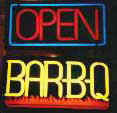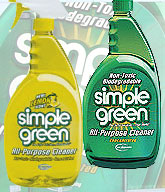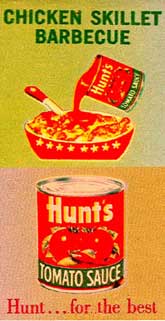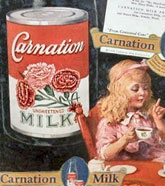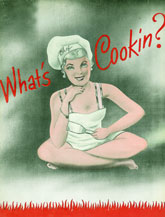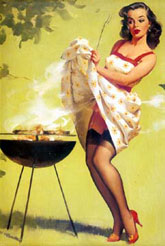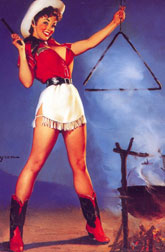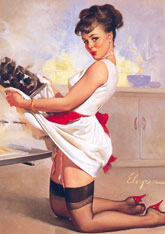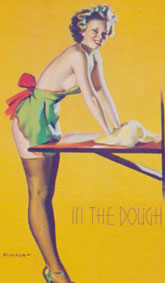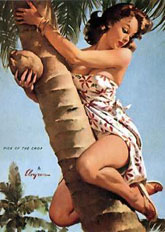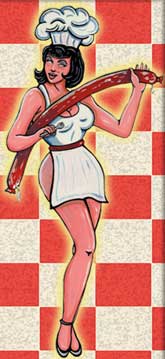Contact BBQbyDan
www.BBQDan.com
Search
KCBS BBQ Cook-Off Info
Recipes,
Smoking Meats
Recipes, Grilling
|
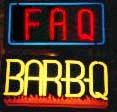 |
FAQ OF THE INTERNET BBQ LIST Version 2.0 Section 11 General Questions About Barbecue |
11. General questions about barbecuing
Editor--
Here's some questions and answers that didn't fit anyplace else.
-------------------
[Can I use a spray bottle for mopping my barbecue?]
Wyndell Ferguson--
Spray bottles work well for oil-based mops if you don't add spices (just oil, Worcestershire, vinegar, hot sauce, etc.). Spray bottles are less messy--no worry about grungy mops, etc.
-------------------
[I tried using a spray bottle, but it kept getting clogged up. I figured the oil was too thick. What can I do?]
Dave Swagler--
Pop the spray bottle in the microwave for about 20 seconds before you mop. It will thin the oil temporarily. Give it a shake and spray away.
-------------------
[Can you put something other than water in the water pan in my smoker?]
Editor--
You sure can. List members report putting wine, fruit juices, beer, spices, Coca Cola and Dr. Pepper. There is some controversy about the beer though, some say it's a waste of good brew. The wine, fruit juices and water with spices can add some flavor to what you're smoking, but most say it's pretty subtle.
-------------------
[I see recipes posted to the List that say Meal-Master and MasterCook. What does this mean?]
Editor--
Most List members use a recipe program to manage their recipes.
The recipe program that has been around the longest is a shareware program called Meal-Master. It currently only works under DOS, but a Windows version is said to be in the works.
Probably the new standard-bearer recipe management program is Sierra On-Line's MasterCook program version 4.1.
A new Windows shareware program called 'Now You're Cooking' is also favored by some of our List members.
All three of these programs work well and will manage your recipes with ease and style. Meal-Master is the most difficult of the three for a newcomer to master as it is command driven. The other programs are very easy to use due to the Windows interface. MasterCook is also available for the Mac. Each program costs around $30.
You can get an evaluation copy of MasterCook. ![]() Click here
Click here
You can download a working copy of Now You're Cooking. ![]() Click here
Click here
You can download a working copy of Meal-Master. ![]() Click here
Click here
-------------------
[Is there any way I can view MasterCook *.mxp files without buying the MasterCook program?]
George Tracy--
I came across this web site that may prove useful for some of you who would like to view the BBQ List's archived recipes without purchasing a cookbook program.
You can download a free copy.![]() Click here This software by Ryan Walberg
allows you to view and print the contents of an *.mxp (MasterCook export) file
alphabetically or by category.
Click here This software by Ryan Walberg
allows you to view and print the contents of an *.mxp (MasterCook export) file
alphabetically or by category.
Editor--The MasterCook export format (*.mxp) is in ASCII text and you can read and print them with a word processor or text editor. However, the program mentioned by George makes this much easier.
-------------------
[I'm new to the List and I live in Oregon. We have a lot of rain in the fall and winter. Can I operate my bullet smoker in the garage with a fan to carry off the smoke?]
Ed Pawlowski--
I'd be hesitant about operating a smoker in the garage. A fan will carry off heat as well as smoke. Do it outside with a tarp thrown over a couple of clothes lines--that's all you need. A sprinkle will not be a problem for the fire, but the water will take away heat from the smoker so some protection from the rain is best.
==============
Wyndell Ferguson--
Your garage will get pretty smoky, not to mention that 'stickiness' that the smoke will leave on things. Best to do it outside.
==============
Tom Kelly--
I would opt for a canvas cover and using the smoker outside (that's how I do it). I don't want all the smoke odor and particulates on my tools, shelves, garden implements, lawnmower, etc. Plus, unless you can get real good ventilation, you could end up taking a long nap--the carbon monoxide from a fire like that would be pretty intense. I just drove a couple good sized nails over the garage door and hooked a tarp to them. At the opposite 2 corners, I attach a couple of 8 foot poles and stake them up with string. Works just fine.
-------------------
[Any tips on loading the vertical water smoker. I want to do some ribs and chicken. Which goes on the top?]
Dwight Inman--
One of the things I like about a vertical design vs. horizontal is the fact that you can put one meat over another, a sort of self-basting effect. I always put pork or briskets on top. Lots of fat drippings, thus more basting.
-------------------
[If I take the meat out of the smoker and put it in foil, should I put some liquid in there with the meat before I return it to the smoker?]
Rock McNelly--
Depends on how moist it was going into the foil, but I personally would use some Club Soda. It doesn't add to, or distort the other flavors in any way, while it adds moisture to the meat. In fact, it takes on the flavor of the meat. If you're planning on eating it the same day, you can smoke it openly for about 3/4's of the estimated time planned for, and then wrap in foil with the Club Soda and continue cooking it in your smoker for the rest of the allotted time. This will percolate that Club Soda into the meat, and really set it off.
Editor—
List members also report that adding apple juice to the foiled meat keeps the it moist.
-------------------
[Should I use something like 'Adolf's Meat Tenderizer' on my ribs before I barbecue them?]
Edwin Pawlowski--
I've never used tenderizer on ribs. A marinade will help, but, most times is not necessary. I just use a rub or some seasonings and not much of those either. The whole point of barbecue is to take tough cuts of meat and smoke cook them low and slow and make them into something really great.
--------------------
[I have a question, maybe dumb, but I really don't know the answer. So I thought I would ask the experts on the porch. Assuming that I am barbecuing meat for 1 1/2 hours per pound, say for a 7 pound Boston butt, I would cook the butt for 10 1/2 hours. If I was to do two 7 pound butts would I then have to cook them for 21 hours?]
Tom Kelly--
Initially, the more meat you have in your smoker, the more BTU's you will need getting up to a stable temperature but it's the same principal as your indoor oven. And with a big smoker, you shouldn't have to add any cooking time at all. As long as the temperature around the meat can be maintained, and you have some separation for airflow, you really should not have to add to your cooking time when you double up on the meat in the smoker. In a smaller smoker, another 30 minutes to an hour may be required, just like cramming 4 baking potatoes into a toaster oven and not expecting them to be done in 1 hour.
-------------------
[I'm confused about sugar. What are 'raw', 'brown', 'turbinado' and 'molasses' sugars?]
Editor--
The Epicurious dictionary (to visit the dictionary, click here) defines these sugars as:
"Today's BROWN sugar is white sugar combined with MOLASSES, which gives it a soft texture. The two most commonly marketed styles of brown sugar are light and dark, with some manufacturers providing variations in between.
"Though similar in color, brown sugar should not be confused with RAW sugar, the residue left after sugarcane has been processed to remove the molasses and refine the sugar crystals. The flavor of raw sugar is akin to that of brown sugar. In this raw state, however, sugar may contain contaminants such as molds and fibers. The so-called raw sugar marketed in the United States has been purified, negating much of what is thought to be its superior nutritive value. Two popular types of raw sugar are the coarse-textured dry DEMERARA sugar from the Demerara area of Guyana, and the moist, fine-textured BARBADOS sugar."
"TURBINADO sugar is raw sugar that has been steam-cleaned. The coarse turbinado crystals are blond colored and have a delicate molasses flavor."
"During the refining of sugar cane and sugar beets, the juice squeezed from these plants is boiled to a syrupy mixture from which sugar crystals are extracted. The remaining brownish-black liquid is molasses. Light MOLASSES comes from the first boiling of the sugar syrup and is lighter in both flavor and color. It's often used as a pancake and waffle syrup. Dark molasses comes from a second boiling and is darker, thicker and less sweet than light molasses. Blackstrap molasses comes from the third boiling and is what amounts to the dregs of the barrel. It's very thick, dark and somewhat bitter.
==============
Kit Anderson--
Turbinado sugar is just sucrose with a little molasses left in. Since the molasses is not on the outside of the crystals like brown sugar, it doesn't clump and is easier to handle.
-------------------
[Should I use turbinado sugar in my rubs instead of white or brown sugar? Will it blacken less?]
Patty Burke-Shelby--
I switched to turbinado sugar. I don't use sugar in my rubs but I do use it in my finishing sauce. It will not blacken as quickly as regular sugar.
==============
Kit Anderson (the List's resident scientist)--
Here's the scoop on carmelization of sugars:
Sugar melts at 320F and becomes molten. On cooling it becomes a non-crystalline brittle mass which is water soluble. At 338F the sugars undergo decomposition resulting in a flavor and color change. This is the process called caramelization.
At temperatures higher than this the sugar burns, becoming very dark brown and bitter tasting.
-------------------
[I can get a good deal on some hardwood pellets for my pellet-fed smoker. Is there any caution I should be aware of?]
Rick Day--
Make sure those pellets are 'FOOD GRADE' pellets and not pellets for heating. Pellets for heating may contain various contaminated products and should be used only in a pellet stove! The heating-type pellets may contain traces of resinous woods such as pine or cedar! Always make sure the pellets say 'BBQ Pellets' or 'FOOD GRADE' pellets before you try to use them in a cooking environment.
--------------------
[I smoked a pork butt today and as I was pulling it, I saw this nasty looking veiny thing next to the bone. What was that and should I throw out the butt?]
Paul Ferguson--
That nasty-looking thing you found was an infected or enlarged lymph node. Just remove it and enjoy the rest of the meat. Next time, look at your meat a little closer before cooking. If you see any little gray/green egg-shaped balls about the size of your thumbnail remove them. These are lymph glands.
-------------------
[Can anyone give me some information on bacterial growth on meat during smoking?]
Marv of Marv's Marvlus Pit Bar-B-Q--
All harmful bacteria are killed by the time the meat reaches a temperature of 160F. So at 200-250F you are cooking safe.
Editor--the general rule for the storage of food is to keep it out of the bacteria danger zone 40-140F. Keep foods subject to bacterial growth within this danger zone no longer than 2 hours.
-------------------
[I love steak. And I also live in an apartment. I was wondering if it which was safe to put a portable barbecue unit under a residential stove hood with the window wide open wood/charcoal/gas/electric?]
Wyndell Ferguson--
Using a barbecue unit with charcoal inside is very dangerous! Charcoal produces carbon monoxide while it's burning. Also, using a charcoal unit indoors is most likely a violation of some major fire codes, if not apartment policy. A better idea is either:
1 Get an electric counter-top grill,
2 get a stove with the grill insert,
3 buy one of those new grill pans.
The folks on Food TV shows seem to like the grill pans, and they aren't that expensive. They even add lines to the food like it was cooked on a grill. I saw a T-Fal grill pan for $20 the other day. They say it keeps the fat from the food, they claim the food being raised up causes the fat to 'vaporize' when it hits and adds that smoky flavor.
==============
Edwin Pawlowski--
I have a gas stove and a gas oven, but will not bring my gas grill inside. First, it will belch smoke from the drippings--more than can be vented properly. Next, it is not insulated. Fire codes (most anyway) call for 36" clearance from anything flammable unless special baffles, etc. are in place. I grill in my wood stove. It is designed to have a fire in it, it is vented by the stack to the outside, and is on a slate pad on a concrete pad in front of a brick wall.
==============
Editor--
The best suggestion in your situation is to take Fergy's suggestion No. 1, get an electric broiler to grill your steaks. Check out the ones made by T-Fal, Hamilton Beech and other manufacturers. They have a grill, a drip pan and an electric heating element. The dripping grease hitting the glowing element burns and flavors the meat, just like a charcoal grill does.
-------------------
[From what I've read on the BBQ List about the process of breaking down the collagen in a brisket over a long period and at a low temperature of 160F is confusing. Some say to keep the smoker temperature high, 240-250F, some say to keep it at 220F and some say to lower the temperature as the time goes on during the smoking process. Can someone help me here?]
Belly--
Let's go over this process one more time as you young kids just never listen to your old father. While smoking a brisket, you want that meat rack temperature to be between 235-240F. This is the good temperature for brisket. Now you have to find out what temperature at the lid gives you a temperature of 235-240F at the meat rack. Could be lid temperature of 250F or 270F. Got to determine that first of all. Let's say that 250F at the lid gives 235F at the meat rack, OK? When your lid temperature is up to a steady 260F put that meat on. Now, the temperature will drop as it warms up the meat to the cooking stage. Now watch that lid temperature and keep it as close to 250F as you can. Now listen up, DO NOT, I SAY DO NOT open up your smoker for next four hours. Just try with all your little heart to keep the temperature at the lid at 250F. After four hours, open the lid and check the meat internal temperature. If it is up to 160F, OK. Now keep an eye on the meat temperature. When it gets up to 165F, you want to let your heat drop a little to about to about 235-240F on the lid thermometer. You can start mopping each hour now. Keep and eye on the meat temperature each hour as you mop. You want the meat internal temperature to get to 180F. If it goes to 190F or over, your meat will become mush-like and dry. So keep watch on your meat temperature and learn to cook by your meat temperature not your smoker lid temperature. If you learn to cook meat this way, your smoker will be lots more friendly.
-------------------
[I'm on a low-sodium diet. Can someone give me some tips about a dry rub without any salt?]
Jeff Lippsit--
I'll toss together sweet Hungarian paprika, brown sugar, garlic powder, onion powder, fresh ground pepper, and a little cayenne. Rub the meat with this mixture and let the meat sit in the refrigerator in a plastic bag overnight. Next day bring the meat to room temperature (30 minutes maximum) while the smoker is coming up to temperature.
If you make extra rub, you can use the rub mixture as the seasoning for a sauce. Just add a few tablespoons to a cup of ketchup, heat, and serve.
==============
Editor--
Some List members on a low-sodium plan like to use Mrs. Dash seasoning blend as a salt replacement. You can also use 'salt substitute' (potassium chloride) in your rubs.
==============
Dave Klose--
Here's a couple of low-sodium rubs:
Low-Sodium Chili Powder
Amount |
Measure | Ingredient | Preparation Method |
3 |
tablespoons | paprika | |
2 |
teaspoons | oregano | finely crushed |
1 |
teaspoon | cumin | ground |
1 |
teaspoon | turmeric | ground |
1 |
teaspoon | garlic powder | |
1/4 |
teaspoon | cayenne pepper |
Mix all ingredients together thoroughly and use in place of chili powder.
Makes 4 tablespoons. Contains no salt as does store-bought chili powder.
Lemon Basil Herb-And-Spice-Seasoned Salt Subs
Amount |
Measure | Ingredient | Preparation Method |
2 |
tablespoons | dried lemon basil or dill | finely crumbled |
1 |
teaspoon | dried oregano leaves | finely crumbled |
2 |
tablespoons | onion powder or | finely ground onion flakes |
1 |
teaspoon | celery seed | |
2 |
tablespoons | sesame seeds | toasted |
1/4 |
teaspoon | dried lemon peel | grated |
1 |
pinch | black pepper | freshly ground |
1/2 |
teaspoon | paprika | |
1/2 |
teaspoon | garlic powder |
Combine all ingredients in a small bowl and blend well. Put into a shaker with large holes. Store in a cool dark place. Makes about 3 ounces. This rub is good on all types of meat.
-------------------
[Can someone tell me something about spices used in barbecue, like how to buy them and how to store them?]
Garry Howard--
When it comes to spices, the rule to follow is 'the fresher the better'. Spices lose their flavor with time, especially after being ground. If you want the ultimate in ground spices, buy whole spices in small quantities, no more than you will use in a couple of months and grind them as you need them. I use a coffee grinder to grind spices. Of course you need to dedicate a grinder to this purpose unless you like strange flavored coffee. To really bring out the flavor in the spices, toast the whole spices before grinding. Stir them around on a hot cast iron griddle for a few seconds to release the flavor. You have to be careful though because it is easy to burn them and then you will have a bitter flavor.
Spices in the grocery store have most likely been sitting on the shelf for quite awhile. When buying from the supermarket stick with whole spices and grind them yourself when possible. Some spices aren't available whole, cayenne pepper for example. Always buy Hungarian paprika. It is very difficult to find a good chili powder in most parts of the country. As Kit Anderson says "The supermarket stuff tastes like cardboard". If you don't have access to a good quality chili powder you are better off making your own or ordering it from a mail order house. Chili powder is one of the most important spices in my opinion, especially if cooking Texas style brisket, and quality is very important. I bought some Gebhardt's the last time I was down in Texas and it will do in a pinch. [See Garry's recipe for chile powder in section 9.1.]
I use supermarket garlic powder and onion powder. I always use kosher salt. I only use Mexican oregano. Most other spices, like coriander, cumin, cardamom, etc. I buy at an Indian grocery market. Luckily, I live in an area with a lot of ethnic markets so I haven't found it necessary to mail order spices. One good all-around seasoning I use a lot is Goya brand Adobo Seasoning. It is good on fish, chicken and eggs and can be used as a substitute for salt in many recipes. It has a pretty high salt content.
Your spices will last longer if you store them in a cool, dark place. Don't hang them on the wall in one of those spice racks in clear glass bottles.
==============
Patrick Lehnherr--
That was an excellent discussion on spices that Garry did, but I'd like to contend one point. You say buy what you will use in a couple of months time, but as I understand it, most spices are harvested once a year. If this is the case, you might as well buy a year's worth and take comfort in knowing how your spices are stored during that year. To really work that to your advantage, find out when the new crop comes in where you buy spices.
==============
Richard Schwaninger--
Exactly, reading Penzey's catalog they explain that most spices are harvested once a year. So when buying whole spices, buy what you need for the year. When buying ground spices, I think they recommend buying enough for six months but you should store it properly (i.e. cool spot and out of sunlight).
==============
Ed Pawlowski--
Once you get good quality spices, you will be particular about all of them. I've been buying from Penzy's and rarely get them at the supermarket. If you are fortunate, you may have a spice shop nearby and if they have a good turnover, you can be assured of freshness and good quality. Chili powder and paprika are a couple that come to mind that are much better than the stuff in the little boxes if you get them from a good source.
==============
Editor--
When you use a small coffee grinder to grind you spices, it is necessary to carefully clean the grinder between uses. You don't want chili-flavored cinnamon. You can use a small brush to carefully clean out the grinder or you can grind up a few soda crackers or a piece of stale bread. Be careful when you want to grind up spices that are heavy with oils, like cloves. They can make a mess of your grinder.
-------------------
[What is the best way to dispose of ashes from the smoker?]
Lloyd Carver--
I use them in leaf mold or compost. The garden just loves the stuff.
==============
Jim Anderson--
I shovel the cold ash into plastic yard bags and scatter them thinly over my raised herb garden and tomatoes. What's left over I donate to the garbage man.
-------------------
[My old chainsaw died on me. What's a good model for a replacement?]
Editor--Summary of several posts--
The experienced BBQ List wood cutters recommended these chainsaw makes:
1 Husqvarna - the hands down winner
2 Stihl - a distant second
3 Echo
4 Poulan
The McCulloch chainsaw was the hands down loser--after a year of use, List members report they turn into door stops.
The List members said to get the biggest and most powerful chainsaw that met your weight, size and budget requirements. They also said to buy it from a dealer that can service and support the saw.
-------------------
[What can you tell me about hanging meat vertically in a smoker?]
Frank Boyer--
I like to smoke whole chickens and turkey breasts by hanging them in my smoker. My wife likes them that way for her catering business--they don't get as much smoke.
==============
Rick Day--
The Willingham smoker utilizes a hanging system on a carousel for the meat. I hang the briskets with the fat cap up and the point down. This allows the fat to self baste the meat in that delicious fat.
-------------------
[What are the nets that you hang meat in called?]
Bill Ackerman--
They are called "stockinette" and I use them for briskets, turkeys, and hams. They're kind of like an elastic cloth bag. The weave is a little like cheesecloth. I soak the bag in vinegar which prevents it from sticking to the meat. I get them from the Sausage Maker, (716) 824-6510. Item #13500C. $5.95 for 10 bags.
You can download all the recipes in this FAQ ![]() Click here
Click here
Go to the next section
Return to the Table of Contents
Return to the BBQ FAQ Home Page
Comments or Suggestions
BBQ FAQ Ver 1.0, 2.0 ©1997, 1998 William W. Wight. All rights reserved.

